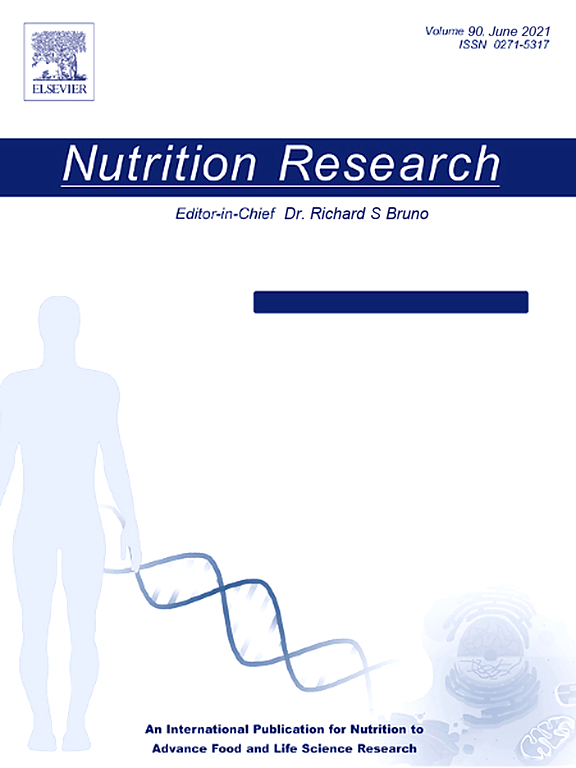Cathelicidin expression in the pathogenesis of atopic dermatitis and the therapeutic potential of vitamin D
IF 3.1
3区 医学
Q2 NUTRITION & DIETETICS
引用次数: 0
Abstract
Atopic dermatitis (AD) is a common inflammatory skin condition. Emerging evidence indicates that alterations in the cutaneous expression of the antimicrobial peptide cathelicidin contribute to AD pathogenesis, including weakened skin barrier (SB) function, and Staphylococcus aureus (SA) colonization. Cathelicidin expression is vitamin D (VD)–dependent and low VD, highly prevalent in AD populations, may impede cathelicidin induction. This review investigates the pathophysiological mechanisms linking cathelicidin expression with SB function and SA colonization/infection, and the impact of VD as a nutritional intervention to target cathelicidin expression, SB function, and SA colonization/infection to inform AD management in clinical practice. We hypothesize that low VD concentrations contribute to reduced cathelicidin expression and the development and/or exacerbation of AD, and interventions to increase serum VD concentrations may upregulate cathelicidin expression and ameliorate AD pathogenesis. A systematic literature search was performed. Sixty-eight peer-reviewed papers were accepted, critically appraised, and summarized in a narrative analysis. Our findings indicate: (1) cathelicidin has a role in SB function and anti-SA activity and (2) VD supplementation (VDS) at doses of 1000–2000 IU/day for 1 to 3 months increases cathelicidin expression and reduces SA abundance and AD severity in individuals with low serum VD. There is no evidence to support the use of VDS in individuals with sufficient serum VD. The results support the use of VDS at 1000–2000 IU/day for 3 months to ameliorate AD pathophysiology when serum VD concentrations are within deficiency/insufficiency ranges. Further clinical research is required to establish optimal dosage and duration for VDS interventions.

抗菌肽在特应性皮炎发病机制中的表达及维生素D的治疗潜力
特应性皮炎(AD)是一种常见的皮肤炎症。新出现的证据表明,皮肤抗菌肽cathelicidin表达的改变有助于AD的发病,包括皮肤屏障(SB)功能减弱和金黄色葡萄球菌(SA)定植。抗菌肽的表达依赖于维生素D (VD),而低VD在AD人群中非常普遍,这可能会阻碍抗菌肽的诱导。这篇综述探讨了将cathelicidin表达与SB功能和SA定植/感染联系起来的病理生理机制,以及VD作为一种针对cathelicidin表达、SB功能和SA定植/感染的营养干预的影响,以指导临床实践中的AD管理。我们假设,低VD浓度有助于降低cathelicidin的表达和AD的发展和/或加重,而增加血清VD浓度的干预可能上调cathelicidin的表达并改善AD的发病机制。进行了系统的文献检索。68篇同行评议的论文被接受,经过严格的评估,并在叙述分析中进行了总结。我们的研究结果表明:(1)cathelicidin具有SB功能和抗SA活性的作用;(2)VD补充(VDS)剂量为1000-2000 IU/天,持续1至3个月,可以增加cathelicidin的表达,降低低血清VD个体的SA丰富度和AD严重程度。没有证据支持在血清VD充足的个体中使用VDS。结果支持在血清VD浓度处于不足/不足范围内时,连续3个月使用1000-2000 IU/天的VDS来改善AD病理生理。需要进一步的临床研究来确定VDS干预的最佳剂量和持续时间。
本文章由计算机程序翻译,如有差异,请以英文原文为准。
求助全文
约1分钟内获得全文
求助全文
来源期刊

Nutrition Research
医学-营养学
CiteScore
7.60
自引率
2.20%
发文量
107
审稿时长
58 days
期刊介绍:
Nutrition Research publishes original research articles, communications, and reviews on basic and applied nutrition. The mission of Nutrition Research is to serve as the journal for global communication of nutrition and life sciences research on diet and health. The field of nutrition sciences includes, but is not limited to, the study of nutrients during growth, reproduction, aging, health, and disease.
Articles covering basic and applied research on all aspects of nutrition sciences are encouraged, including: nutritional biochemistry and metabolism; metabolomics, nutrient gene interactions; nutrient requirements for health; nutrition and disease; digestion and absorption; nutritional anthropology; epidemiology; the influence of socioeconomic and cultural factors on nutrition of the individual and the community; the impact of nutrient intake on disease response and behavior; the consequences of nutritional deficiency on growth and development, endocrine and nervous systems, and immunity; nutrition and gut microbiota; food intolerance and allergy; nutrient drug interactions; nutrition and aging; nutrition and cancer; obesity; diabetes; and intervention programs.
 求助内容:
求助内容: 应助结果提醒方式:
应助结果提醒方式:


